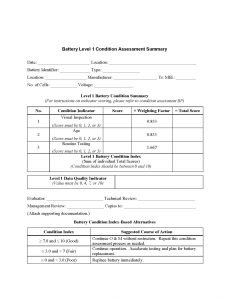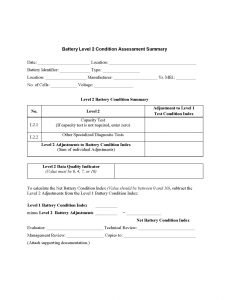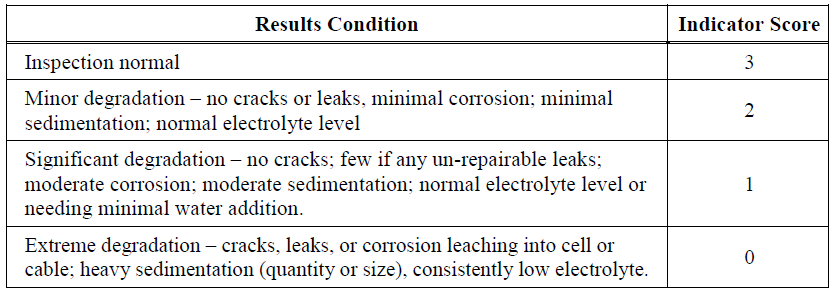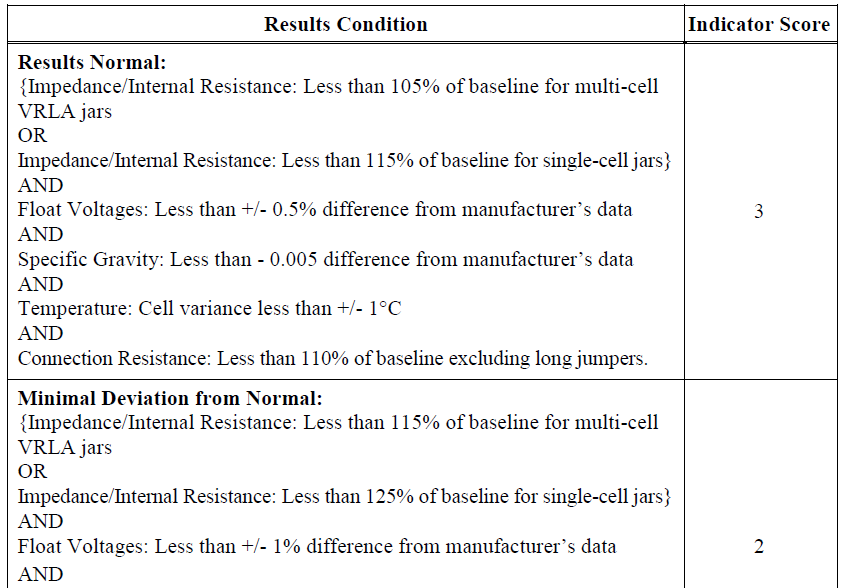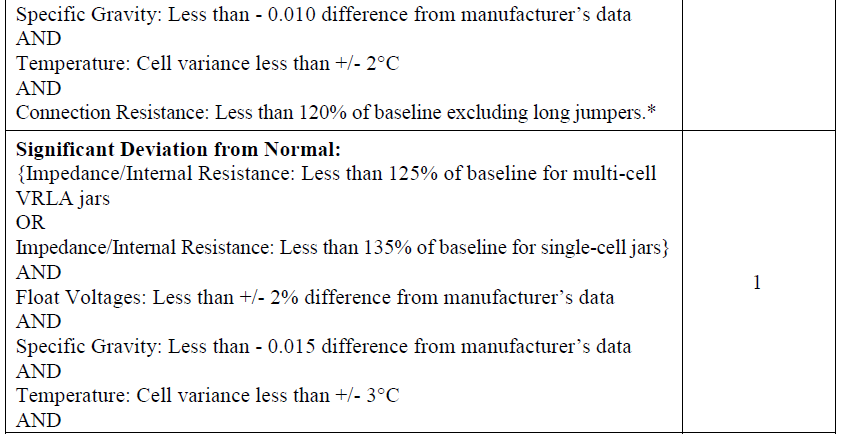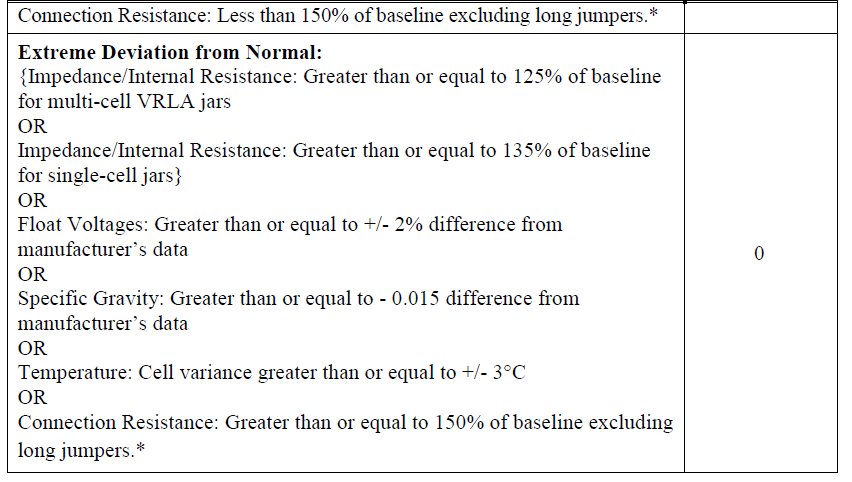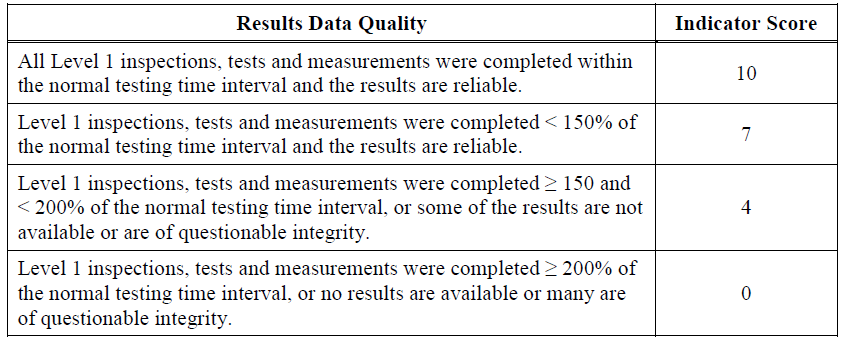1. Scope
4. References
5. Instructions
6. Introduction
7. Application
8. Condition and Data Quality Indicators and Battery Condition Index
9. Inspections, Testing, and Measurements
10. Scoring
11. Weighting Factors
12. Mitigating Factors
13. Documentation
14. Condition Assessment Methodology
15. Level 1 – Inspections, Tests, and Measurements
16. Level 1 – Battery Condition Index Calculations
17. Battery Data Quality Indicator
18. Level 2 – Inspections, Tests, and Measurements
19. Battery Condition Index Calculation
20. Battery Condition-Based Alternatives
Battery Condition Assessment
1 Scope
This best practice provides guidelines for conducting Battery Condition Assessments on battery systems currently in operation. The guidelines provide a method for determining a Score from the results of specified battery inspections, testing, and measurements which can then be utilized to select various battery condition based alternatives.
4 References
4.2 Industry Codes and Standards
Institute of Electrical and Electronics Engineering, Inc.
IEEE 450 Recommended Practice for Maintenance, Testing, and Replacement of Vented Lead-Acid Batteries for Stationary Applications
IEEE 1106 Recommended Practice for Installation, Maintenance, Testing, and Replacement of Vented Nickel-Cadmium Batteries for Stationary Applications
IEEE 1188 – 1996 Recommended Practice for Installation, Maintenance, Testing, and Replacement of Valve-Regulated Lead-Acid (VRLA) Batteries for Stationary Application.
5 Instructions
This guide is not intended to define battery maintenance practices or describe in detail battery condition assessment inspections.
Guidance and recommendations herein are based on industry standards and practices. However, equipment and situations vary greatly, and sound engineering and management judgment must be exercised when applying these diagnostics. All available information must be considered, for example, manufacturers’ and battery experts’ recommendations, unusual operating conditions, personal experience with the equipment in conjunction with this document.
6. Introduction
Stationary batteries are key components in any Saudi Aramco plant and are appropriate for analysis under a condition assessment program. Batteries provide essential backup power for critical loads. Upon failure of either the normal power or the battery charger, or UPS rectifier, in case of UPS system, the battery is the only remaining supply of energy to protect the critical loads during abnormal conditions. Failure of the battery can be catastrophic to plant equipment and systems, as well as a risk to the power system.
Many abnormal battery conditions detected through regular maintenance can be corrected. Under certain circumstances, individual cells may be replaced. However, some conditions indicate complete battery replacement. A strategy for detecting and dealing with failing batteries is important to improving the reliability of the plant. Determining the present condition of batteries is an essential step in analyzing the risk of failure. This Best Practice (BP) provides a process for arriving at a Battery Condition Index which may be used to develop a business case addressing risk of failure, economic consequences, and other precautionary measures.
7. Application
The battery condition assessment methodology outlined in this Best Practice (BP) applies to vented lead-acid (VLA) (often called “flooded” or “wet cell”) type, valve-regulated lead-acid (VRLA) type and nickel-cadmium (NiCd) type. This methodology may be used to determine alternatives for continued maintenance or battery replacement. This BP is not intended to define battery maintenance practices or describe in detail battery condition assessment inspections, tests, or measurements.
8. Condition and Data Quality Indicators and Battery Condition Index
The following three condition indicators are generally regarded by Saudi Aramco engineers as providing a sound basis for assessing battery condition:
Visual Inspection
Age
Routine testing
These condition indicators are initially evaluated using Level 1 inspections, tests, and measurements, which are conducted by maintenance technicians or contractors over the course of time and as a part of routine maintenance activities. Numerical scores are assigned to each condition indicator, which are then weighted and summed to determine the Battery Condition Index.
In addition, a stand-alone indicator is used to reflect the quality of the information available to score the Battery Condition Index. In some cases, data may be missing, out-of-date, or of questionable integrity. Any of these situations could affect the accuracy of the associated condition indicator scores as well as the validity of the condition index. Given the potential impact of poor or missing data, the Data Quality Indicator is used as a means of evaluating and recording confidence in the final Battery Condition Index.
The BP also describes Level 2 inspections, tests, and measurements that may be applied depending on the specific problem being addressed. Level 2 tests are considered non-routine. If Level 2 data is readily available, it may be used to supplement the Level 1 assessment.
Alternatively, Level 2 tests may be deliberately performed to address Level 1 findings. Results of the Level 2 analysis may either increase or decrease the score of the Battery Condition Index. The Data Quality Indicator score may also be revised during the Level 2 assessment to reflect the availability of additional information or test data.
The methodology described in this BP is valid only if a study of battery capacity versus present load has been performed and that the capacity is adequate. If capacity is not adequate, replacement is mandatory and the condition methodology described herein is not applicable.
9. Inspections, Testing, and Measurements
Inspections, tests, and measurements should be conducted and analyzed by qualified staff suitably trained and experienced in stationary battery diagnostics and on a frequency that provides the accurate and current information needed by the assessment. More complex inspections and measurements may require a battery diagnostics “expert” or specialist.
Results of the battery condition assessment may cause concerns that justify more frequent monitoring. Maintenance agency should consider the possibility of taking more frequent measurements or installing computerized battery monitoring system that will continuously track critical quantities and automatically perform tests. This will provide additional data for condition assessment and may provide a certain amount of reassurance in continuing to operate the battery as maintenance / replacement alternatives are being explored.
10. Scoring
Battery condition indicator scoring is somewhat subjective, relying on battery condition experts. Relative terms such as “Results Normal” and “Degradation” refer to results that are compared to industry accepted levels; or to baseline or previous (acceptable) levels on this equipment; or to equipment of similar design, construction, or age operating in a similar environment.
11. Weighting Factors
Weighting factors used in the condition assessment methodology recognize that some Condition Indicators affect the Battery Condition Index to a greater or lesser degree than other indicators. These weighting factors were arrived at by consensus among many battery maintenance technicians and engineering specialists with extensive experience.
12. Mitigating Factors
Every battery system is unique and, therefore, the methodology described in this BP cannot quantify all factors that may affect individual battery condition. It is important that the Battery Condition Index arrived at be scrutinized by engineering experts. Mitigating factors specific to the battery system may determine the final Battery Condition Index and the final decision on replacement.
13 Documentation
Providing the proper documentation and records is essential to support findings of the assessment. Test results should accompany the Battery Condition Assessment Summary form.
14. Condition Assessment Methodology
The condition assessment methodology consists of analyzing each condition indicator individually to arrive at a condition indicator score. The score is then weighted and summed with scores from other condition indicators. The sum is the Battery Condition Index.
Reasonable efforts should be made to perform Level 1 inspections, tests, and measurements. However, when data is unavailable to properly score a condition indicator, it may be assumed that the score is “Good” or numerically equal to some mid-range number such as 2. This strategy must be used judiciously to prevent erroneous results and conclusions. In recognition of the potential impact of poor or missing data, a separate Data Quality Indicator is rated during the Level 1 assessment as a means of evaluating and recording confidence in the Battery Condition Index.
15. Level 1 – Inspections, Tests, and Measurements
Level 1 inspections, tests, and measurements are routinely accomplished as part of normal operation and maintenance, or are readily noticeable by examination of existing data. Level 1 test results are quantified below as condition indicators that are weighted and summed to arrive at a Battery Condition Index. Level 1 inspections, tests, and measurements may indicate abnormal conditions that can be resolved with standard corrective maintenance solutions. Level 1 test results may also indicate the need for additional investigation, categorized as Level 2 tests.
Battery Condition Indicator 1 – Visual Inspection
Visual inspection is an easy yet effective way to begin assessing battery condition. Battery cells should be in good condition even if the battery has been in service for many years. In the case of vented lead-acid (VLA) batteries or nickel cadmium (NiCd) batteries, inspection may include levels and colors of sedimentation at the bottom of the cells; condition of plates; level of electrolyte; condition of flame arresters; leaks, cracks, and corrosion of cell casing and terminals.
For valve-regulated, lead-acid (VRLA) batteries, inspection should include looking for bulges, leaks, and cracks in cell casings and corrosion of cell terminals.
Results of visual inspection are applied to Table 1 to arrive at an appropriate Condition Indicator Score.
Table 1 – Visual Inspection Scoring
Battery Condition Indicator 2 – Age
Battery age is important as an indicator of remaining life. VLA and NiCd batteries have life expectancies of about 20 years if properly maintained. VRLA batteries have significantly less life – typically 5 to 7 years – and must be maintained much more carefully than VLA batteries. Therefore, many utilities and industrial organizations do not use VRLA batteries as storage batteries.
Apply the battery age to either Table 2 or Table 3 to arrive at the Condition Indicator Score.
Table 2 – Age Scoring – Vented Lead-Acid (VLA) or NiCd Battery
Table 3 – Age Scoring – Valve Regulated Lead-Acid
Battery Condition Indicator 3 – Routine Testing
Maintenance departments conduct routine testing of batteries as part of a scheduled maintenance program. Test types and frequency vary between plants but often include the following tests and measurements:
Vented Lead-Acid (VLA) and NiCd:
Impedance or internal resistance test
Battery and cell float voltages
Specific gravity readings
Temperature readings
Connection resistance
Valve-Regulated Lead-Acid (VRLA):
Impedance test or internal resistance
Battery and cell float voltages
Temperature readings
Connection resistance
Qualified personnel should make a subjective determination of scoring that encompasses as many operation and maintenance factors as possible under this indicator.
Results of Routine Testing are analyzed and applied to Table 4 to arrive at an appropriate Condition Indicator Score.
Table 4 – Routine Testing Scoring
* Connection resistance is not an indicator of battery capacity unless the resistance cannot be reduced by cleaning and re-torquing to manufacturer’s recommendations.
The impedance test is a primary indicator of battery capacity. Regardless of the results of other routine tests (or age or visual inspection) or the Level 1 Battery Condition Index score, if the impedance test shows severe degradation, then an immediate capacity test as described in Level 2 is indicated.
16. Level 1 – Battery Condition Index Calculations
Enter the condition indicator scores from the tables above into the Battery Condition Assessment Summary form at the end of this document. Multiply each condition indicator score by the Weighting Factor, and sum the Total Scores to arrive at the Level 1 Battery Condition Index.
17 Battery Data Quality Indicator
The Battery Data Quality Indicator reflects the quality of the inspection, test and measurement results used to evaluate the battery condition. The more current and complete the inspections, tests, and measurements, the higher the rating for this indicator. The normal testing frequency is defined as the organization’s recommended frequency for performing the specific inspection, test, or measurement.
Qualified personnel should make a subjective determination of scoring that encompasses as many factors as possible under this indicator.
Results are analyzed and applied to Table 5 to arrive at a Battery Data Quality Indicator Score.
Table 5 –Battery Data Quality Scoring
Enter the Battery Data Quality Indicator Score from Table 5 into the Battery Condition Assessment Summary form at the end of this document.
18. Level 2 – Inspections, Tests, and Measurements
Level 2 inspections, tests, and measurements generally require specialized equipment or training, may be intrusive, or may require an extended outage to perform. A Level 2 assessment is not considered routine. Level 2 inspections are intended to affect the Battery Condition Index established using Level 1 but also may confirm or refute the need for more extensive maintenance, recondition, or battery replacement.
For Level 2 assessments performed, apply the appropriate adjustment factor and recalculate the Battery Condition Index using the Battery Condition Assessment Summary form at the end of this document. An adjustment to the Data Quality Indicator score may be appropriate if additional information or test results were obtained during the Level 2 assessment.
Test L2.1: Battery Capacity Test
The battery capacity or load test is generally regarded by battery specialists as the only conclusive test for determining battery condition. The capacity test determines the battery’s ability to provide power over a predetermined period of time. If the battery cannot pass the vtest, replacement of the entire battery should be considered, possibly even required, in the interest of preventing the problems described above. Replacement of a failing battery should take place before the battery is required to respond in an emergency.
The impedance test (see Level 1) identifies batteries and cells that might not have sufficient capacity. The capacity test is clearly indicated for batteries that do not pass the impedance test.
Despite popular myth, the capacity test in not destructive to the battery. A healthy battery will not be negatively affected by a load test. Capacity testing is supported by IEEE, NFPA, battery manufacturers, and most battery experts. It is the only effective way to measure the battery’s ability to meet an emergency demand.
Whether the capacity test is regularly scheduled or triggered by Level 1 tests, this BP assumes that test results are current and accurate. In some cases, it may be necessary to conduct the capacity test to complete this assessment. If Level 1 tests score highly (i.e., a Level 1 Condition Index of “Good”) and Level 1 tests are current (i.e., a high Data Quality Indicator) and a Capacity Test has been performed recently, conducting the Capacity Test may not be necessary. The plant’s maintenance practice should be consulted.
Results of the Battery Capacity Test are applied to Table 6 to arrive at an appropriate Condition Indicator Score. Battery capacity test shall be performed per SAEP-350.
Table 6 – Battery Capacity Test
Test L2.2: Other Specialized Diagnostic Tests
Additional tests may be applied to evaluate specific battery problems. When conclusive results from other diagnostic tests are available, they may be used to make an appropriate adjustment to the Battery Condition Index.
19. Battery Condition Index Calculations
Enter the Level 2 adjustments from the tables above into the Battery Condition Assessment Summary form at the end of this BP. Subtract the sum of these adjustments from the Level 1 Battery Condition Index to arrive at the Net Battery Condition Index. Attach supporting documentation. An adjustment to the Data Quality Indicator score may be appropriate if additional information or test results were obtained during the Level 2 assessment.
20. Battery Condition-Based Alternatives
After review by a battery expert, the Battery Condition Index is suitable for use in a risk and-economic analysis model. The condition index may be deemed sufficient in itself for decision-making regarding battery alternatives, in which case the Battery Condition Index may be directly applied to Table 7.
Table 7 – Battery Condition Index-Based Alternatives
Battery Level 1 Condition Assessment Summary
